Top Honey Plants for Producing the Best Honey
So why don't bees work certain flowers? Well, for a start, it is no use planting red geraniums and hoping to attract bees to your garden because bees cannot see red. On the other hand, bees are attracted to blue, white, yellow, and purple colored flowers.
Different Flowers produce Different Honey
In addition, the kinds of flowers your plants will use to make honey will affect the taste and color of the honey. The lightest colored honey is very mild in taste.Sweet clover, clover and alfalfa will produce a light, mild honey.
Orange blossom, and other citrus trees, tupelo trees, wild sage, buckwheat, horse mint, basswood and the tulip tree will all produce a darker, stronger honey than those plants above, but will still be mild in taste.
The darkest honey is produced from buckwheat.
If you were just wanting to attract bees to your garden there are some flowers and plants highly sought out by bees:
10 Flower Plants Honey Bees Love
| 1. Dandelion | 2. Fennel |
| 3. Lavender | 4. Nasturtium |
| 5. Ox-eye Daisy | 6. Rosemary |
| 7. Snapdragon | 8. Sunflower |
| 9. Teasel | 10. Yarrow |
However, as a professional beekeeper, one has to look at honey plants on a much bigger scale.
Some beekeepers have made a practice of planting an acre or two of such plants as buckwheat, thinking that this will give them a regular fall feast to the honey gatherers. It is true that buckwheat does yield nectar in tremendous amounts, but an acre or two would be only a drop in the ocean for the average apiary.
One must realize that a colony of bees contains many thousands of individuals, each of whom ranges over an extensive territory and carries home only very small amount of honey-making material.
Any honey plants must be those that not only produce quantities of nectar but which also occur in sufficient numbers to provide the necessary bulk of nectar.
Comparatively few flowers fulfill those two conditions although a great many serve to supply the bees with moderate amounts of nectar and thus help to tide them over the lean portions of the summer.
The following honey plants and flowers have been proven to produce some of the best honey for beekeeping and we hope that this article will be useful to you for the next honey season.
White Clover as Honey Plants
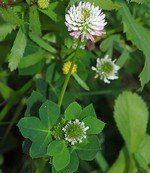 White clover
has long been the
leading honey plant. At one time the yield from white clover probably
exceeded that from any other plant, but with changing conditions it has
become less common.
White clover
has long been the
leading honey plant. At one time the yield from white clover probably
exceeded that from any other plant, but with changing conditions it has
become less common. Formerly every pasture contained patches of this clover so dense as to constitute almost a "pure stand," but with the better understanding of crop rotation the old pastures have been broken up and seeded to other crops.
As a result the white clover has been driven back to road sides, fence corners and abandoned fields where it still thrives and still produces limited amounts of its beautiful honey. The plant is not a native to America, but was probably introduced from Europe or Western Asia very early in the settlement of the country. It is claimed to be identical with the "Shamrock" of Ireland although many Irishmen would dispute this.
The yield from white clover as a honey plant is often dependent upon the weather conditions to a very great extent. Being a biennial it must grow from the seed one season and bloom the next. Consequently, cool, moist summers are favorable to the growth of new plants for the next year; but if we have cool, moist weather during the blooming period the secretion of nectar is retarded and the consequent honey crop is short.
On the other hand, warm weather, and particularly warm nights, during the blooming period tends to promote nectar secretion and the crop may be expected to be large in proportion. Such secretion, however, may be cut off entirely if the weather is too hot and dry, for under these conditions the period of bloom is very short, the plants dry up and die and the white clover honey flow is over for another year.
All of these factors have a very important bearing on the management of the apiary and show how necessary it is that the beekeeper have his colonies ready to gather the white clover nectar promptly. Sometimes the flow will last for weeks and again it may be a matter of a few days and the beekeeper who is not ready for it when it comes will fail to reap any profit.
The same thing is true, in a lesser degree perhaps, with most other honey plants. It is important that the beekeeper know from what plants his surplus is most liable to come from and then be prepared to secure that surplus promptly when the time comes.
Sweet Clover as Honey Plants
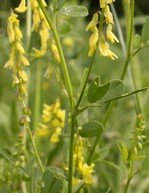 The introduction of sweet clover,
an European weed, into the white clover sections has had something to
do with the crops from the older plant. Both bloom at about the same
time and as a result the fine white clover honey is contaminated with
the greenish colored product of the sweet clover. While the latter is
by no means a bad honey it does not rank with the white clover and the
mixture has been the means of practically eliminating the older honey
from the market.
The introduction of sweet clover,
an European weed, into the white clover sections has had something to
do with the crops from the older plant. Both bloom at about the same
time and as a result the fine white clover honey is contaminated with
the greenish colored product of the sweet clover. While the latter is
by no means a bad honey it does not rank with the white clover and the
mixture has been the means of practically eliminating the older honey
from the market. Sweet clover, when mixed with white clover honey, causes this unpleasant sensation in a minor degree and this is one of the reasons why I have never been friendly to the introduction of this new plant. Each year it is more and more difficult for me to secure honey for my own use — I have long since given up trying to produce it in my own locality.
When pure white clover honey was a standard product one could count on a crop of palatable comb every year, but then that was the childhood days.
Alsike Clover as Honey Plants
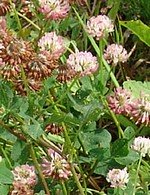 Alsike clover has
been widely
planted as a honey plant to take the place of the red clovers usually
grown for that purpose. In the sections where it will grow it should be
more widely planted as it produces a better quality of hay and often a
larger quantity than does the red clover.
Alsike clover has
been widely
planted as a honey plant to take the place of the red clovers usually
grown for that purpose. In the sections where it will grow it should be
more widely planted as it produces a better quality of hay and often a
larger quantity than does the red clover. It is grown in the same way as red clover and in soils adapted to its culture will live from year to year and about as long as the red. On dry soils it does not succeed and soon "runs out" leaving the field to weeds.
The honey produced is very similar to that from white clover, and probably many consumers will fail to distinguish one from the other. It has become an important honey plant in many sections and should become still more important each year.
Ordinary red clover yields large amounts of nectar. Perhaps I should say it secretes large amounts of nectar because the flower tubes are so deep that the bees cannot reach the nectar content.
Consequently we lose tremendous amounts of honey every season simply because the bees are not built to retrieve the nectar successfully from the red clover. However, in hot dry weather, the flowers of the red clover are so stunted in size that the bees appear to be able to reach the nectar under these conditions.
Crimson Clover as Honey Plants
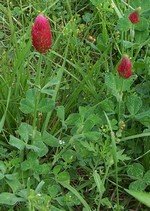 Crimson clover,
another honey
plant of value, has been considered a very important honey-yielding
plant. It is planted late in summer and produces flowers early the next
season.
Crimson clover,
another honey
plant of value, has been considered a very important honey-yielding
plant. It is planted late in summer and produces flowers early the next
season. The bloom comes between the fruit bloom and that of white clover and for this reason is rather important in white clover sections. Ordinarily there is a long gap between fruit bloom and clover which does not supply the bees with as much forage as they should have in order to enable them to build up their colonies.
With more general planting of crimson clover in the white clover districts this gap would be effectively bridged and while a great increase in the crop might not be expected we would at least find our bees in better position to give an account of themselves during the heavy white clover flow.
Alfalfa as Honey Plants
Alfalfa, another important clover, has become a great factor in honey production. The honey from it is not quite so fine as the best white clover honey, but it ranks near the top in the matter of quality and always finds a ready market.It should be remembered that alfalfa is usually cut for hay just as it comes in bloom and as a result the large hay ranches do not supply the bee pasturage that might be expected. It is only where the plant is allowed to ripen its seed that great returns are obtained and in these sections apiary locations are often at a premium — so eagerly are they sought.
American Linden (Basswood) and Sourwood as Honey Plants
The flowers of this tree are pendant and hard dashing rains do not remove the secreted nectar at the base of the petals. Like all other flowers, however, it yields most nectar during periods of warm nights.
The tree is so useful in honey production that the beekeeper can well afford to take the time to plant it along his roads and around his home. It makes an admirable shade tree, blooms at an early age, and as it grows older becomes an important pasturage factor in the life of the bee.
Ten trees, twenty years old, ought to supply a colony of bees with enough nectar to enable them to store a considerable surplus of honey and while some of us may not be here twenty years hence it is pretty certain that someone else may and it is possible too that "someone else" may want to keep bees.
However, there are also those who will say that their top tree for feeding bees is the sourwood tree, also known as the sorrel tree. In the USA it is found in the foothills of the Piedmont to elevations of 3,000 ft. The sourwood try has been used medicinally for centuries. The leaves, although tart in taste will quench your thirst if there is not water about and has not only been used a diuretic but also the leaves can be used to give off a black dye for wool dyeing. However, it is in early July when the tree bears its waxy-white blossoms that bring out the bees in full force that is of interest to us here. Sourwood honey is thick and yellow in color and well sought after. So well sought after in fact, that Sourwood honey is placed on the same status level for medicinal properties as Manuku honey from New Zealand.
The Tulip
Poplar as Honey Plants
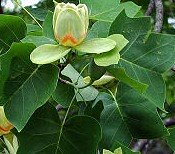 Another native American tree
that yields large amounts of honey was the
tulip tree
or yellow poplar.
The great cup-shaped
flowers sometimes contain an abundance of nectar from which the bees
make a strong dark honey, unsuited for human food but of value in brood
rearing.
Another native American tree
that yields large amounts of honey was the
tulip tree
or yellow poplar.
The great cup-shaped
flowers sometimes contain an abundance of nectar from which the bees
make a strong dark honey, unsuited for human food but of value in brood
rearing. 
Sumac as Honey Plants
In some parts of America the smooth or black sumac yields tremendous quantities of honey. It is a plant of dry hillsides and is often found in those portions of the low hill country where clover is scarce and where the native basswood has mostly been cut out. In such situations it sometimes gives the beekeeper a surplus in years when all other plants fail to make a showing.Fireweed as Honey Plants
Fireweed, also known as Great Willow Herb in Canada, and Rosebay Willow Herb in the UK, that pink flowered wanderer that takes possession as quickly as the fire has made a place for it. The tall stalks, sometimes reaching a height of six feet, are topped with a duster of bloom that grows with the season and unfolds a succession of flowers from July until frost. The honey that the bees obtain from the fireweed is nearly as fine as that from white clover.Wild Raspberry as Honey Plants
The wild raspberry contributes a very large share of a honey crop. The drooping bloom which opens in early summer (late May or early June) resembles the linden in that the nectar is not easily washed out by rain. This drooping character of the bloom of these two important honey plants may account for the fact that both of them are reliable yielders practically every year.The raspberry honey is white in color and has a delightful flavor that easily places it commercially with white clover — the inevitable standard of excellence among all men who produce honey.
In many parts of the country the "fall flow" is the important source of the commercial honey crop. In these sections the beekeeper must manage his colonies in such a way as to have them at their maximum strength just at the time when this flow is ready to be harvested. In such an area it would be crazy to build up strong colonies in the spring and perhaps be forced to feed them over the hot weather — during which there is nearly always a scarcity of bloom.
Buckwheat as Honey Plants
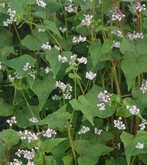 Buckwheat, cultivated in some places
for its grain
and in other places
as a cover crop, produces a dark honey with a very characteristic
flavor. It is enjoyed by many who have acquired a taste for it, but for
those familiar with white clover honey, the product of the buckwheat
offers small appeal.
Buckwheat, cultivated in some places
for its grain
and in other places
as a cover crop, produces a dark honey with a very characteristic
flavor. It is enjoyed by many who have acquired a taste for it, but for
those familiar with white clover honey, the product of the buckwheat
offers small appeal. To many folk buckwheat honey is a standard for comparison just as white clover is for others. The two honeys do not resemble each other in the least and those used to to buckwheat would find the light and delicately flavored clover rather insipid.
While the buckwheat yields tremendous amounts of nectar one shouldn't plant it with the sole aim of securing the honey crop. In places where it is grown for grain the beekeepers reap the incidental harvest of the honey. This process might easily be reversed by planting the grain for the benefit of the bees and considering the grain as incidental to the honey produced.
Heartease as Honey Plants
Related to the buckwheat is heartsease, a member of the smartweed family. It grows in swamps and in wet places near stream banks. Often it occurs to such an extent that profitable yields are obtained and in a few locations tremendous surplus has been recorded. The honey is light amber in color, stronger than clover but still mild enough to find a ready market. A great variation in the honey is liable to occur because there are several varieties of the plant and other honey is liable to be mixed with it.Asters, Goldenrod and Sunflowers as Honey Plants
Asters of many kinds, goldenrod and numerous sorts of "wild sunflowers" supply the bulk of the fall honey. Many of these plants live in low wet places and marshes and have long been a favorite location for commercial beekeepers. With such a wealth of flora to draw upon it is to be expected that there will be a blend from many flowers.For this reason we seldom ever find samples of "pure" aster, goldenrod or sunflower honey. All of them furnish a dark colored product, strong in flavor and not to be compared with the beautiful white honey from other plants. However, this dark honey finds a market and often the quotations are but little below those for clover.
Honey Dew
Speaking of dark honey reminds me that a word should be said about "honey dew."Frequently we find in the hives a dark strong substance that appears to be honey but that obviously is not. The bees gather it and store it exactly as they would the product from the flowers but they get it from aphids who exude this substance.
Honey dew is nothing more or less than an excretion from the "honey tubes" of the aphids that feed on many plants. Some seasons the bees will gather tremendous quantities of this stuff and load up their storage space pretty liberally. It serves them well for brood rearings in the spring, but when it is gathered late in summer and used as winter food it often causes serious damage.
Spring Blooming Honey Plants for Bee Forage
- elm
- maple
- dandelion
- hawthorn
- red bud
- fruit trees
- shadbush
- tulip tree
- willow
- sorrel
The earliest blooming plants furnish practically no nectar but they do furnish what is quite as important to the bee, and that is pollen. Some of them, like the hazel, furnish pollen in tremendous quantities. Following the hazel bloom, the pussy willow and true poplars supply pollen in almost unlimited quantities.
The dandelion, that lowly source of "spring greens," cursed by the lovers of trim lawns, furnishes pollen in abundance and often at a time when the bees are needing this adjunct to their nursery menu. Without pollen brood rearing in the hive would have to cease so it is quite as important that the bees have access to it as that they later have access to a source of nectar.
The bloom on the fruit trees is by far the most important source of the early spring honey and some years it is so lavish that the bees store more than they will need. We have often been able to remove a small surplus of pure apple honey and found it to be of good quality though a trifle darker than the best clover.
Usually it is mixed with the honey from plums, peaches and other tree fruits and the resulting blend, is not as good as pure apple.
So important is the fruit bloom to the beekeeper that in sections where he has been depending upon it he must make other provisions in years of failure. If the trees fail to bloom or if the bloom is killed by cold, it is almost a certainty that the bees will have to be fed before the early summer flowers arrive.
Maple and red maple, phlox, chives, heather, chestnut, hawthorn, honeysuckle, apple blossom, black cherry blossom, black locust, purple deadnettle are all good spring bee forage.
Summer Blooming Honey Plants for Bee Forage
Here are some of the top plants honey bees love that flower in summer:- clovers
- alfalfa
- wild sweet clover
- raspberry
- bee-balm
- blueberry
- chestnut
- corn
- fig-wort
- locust
- basswood
- catnip
- horse mint
- mustard
- sage
- sumac
Milkweed or silkweed as it is sometimes called are worked by bees but with disastrous consequences as the bees often get stuck to this flower and die in the process.
Clover will bloom during this time. Although red clover is also worked by bees the nectar is difficult to get to by the bees, unlike the sweet or white clover. Getting the nectar out of red clover is hard work because the tube of the corolla is longer and the bee appears to have difficulty in reaching it. If white clover is presented, it is preferred by the bees.
Basswood is one of the best bee plants around during this time of the year. It produces a lot of nectar for the bees every alternate year, so cannot be relied on to produce all the food the bees will need year, after year. Therefore, by planting the clovers as well, this will help to fill the gap.
Catnip, (Nepeta Cataria,) Motherwort, (Leonurus Cardiaca,) and Hoarhound, (Marrubium Vulgare,) bloom around the middle of June, and like the Raspberry, the bees visit them at all hours and in nearly all kinds of weather. Catnip has along blooming period, sometimes up to 12 weeks, where the others will only blossom from 4-6 weeks.
Ox-eye daisy, (Leucanthemum Vulgare,) often found in pastures also contains some honey. The flower is compound, and each little floret contains particles so minute, that the task of obtaining a load is very tedious. It is only visited when the more copious honey-yielding flowers and plants are scarce. It has a long flowering season from May - September.
Snap-dragons, (Linaria Vulgaris,) is an all-time favorite of bees as honey plants, and the Bush honeysuckle (Diervilla Trifida) is another particular favorite.
Other summer plants for bees during this time are chicory, smartweed, birdsfoot trefoil, sumac, Joe Pye weed, purple loosestrife, New England aster, goldenrod and spotted knapweed.
Fall / Autumn Blooming Honey Plants for Bee Forage
Here are some of the top plants honey bees love that flower in the fall:- buckwheat
- spider flower
- sunflowers
- fireweed (rosebay willow herb)
- smartweed
- milkweed
- goldenrod
- aster
- rape
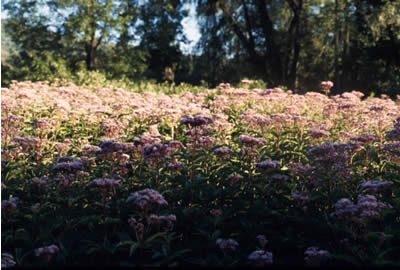 New England aster, goldenrod, spotted knapweed and
Joe Pye weed
from summer will
continue to bloom into autumn or fall and feed your bees.
New England aster, goldenrod, spotted knapweed and
Joe Pye weed
from summer will
continue to bloom into autumn or fall and feed your bees. This is the time when the goldenrod comes into its own.
Joe Pye Weed above
Sometimes, earlier in the season, there is not much nectar coming from the goldenrod, and bees will choose other honey plants to get the nectar from. However, in the fall, the goldenrod is ripe for the picking and the bees will work the goldenrod more during late summer and the fall, than the earlier periods.
Honey Plants you Should Not Keep for Beekeeping
Certain bee plants are not good for honey making as the honey it produces can cause severe illness resulting in abdominal pains, nausea, headaches and even vomitting. This is what is known as poisonous honey.Plants such as rhododendrons, azaleas, monk's hood all contain a glucoside of andromedotoxin. Nectar from leather-leaf and the marsh tea plant will also give you poisonous honey.
Strangely, plants that are known to be poisonous to man such as hemlock, oleander, henbane and foxglove are perfectly safe for nectar collection and honey making.
If in doubt as to where the nectar has come from you will need to heat treat your honey to destroy the toxins, but not to the point where you destroy the organoleptic properties. Heating the honey to 47 degrees C. at a pressure of 67 mm should do it.
The Importance of Honey Plants
Altogether there is a rather close partnership between the bee and the flower. Each is dependent upon the other to a very great extent — that sort of dependence which is extremely common in many of nature's works.The beekeeper should understand this dependence as no one can successfully manage bees unless he also knows something of the flowers which supply the basis for his work.
If you would like to advertise your farm in Europe for free because you need some help on the farm to pick those crops, or whatever, see our section on farming jobs worldwide. Or, if you want to advertise your farm produce, farm accommodation or a farm service look at our section Advertise your Farm. Please feel free to contact us for any further inquiries.
Leave a Comment or a Picture of Honey Plants
Do you have anything that you would like to add after reading this page? We would love to hear your thoughts. If you can add additional information to what has been written here you will be adding value to the website! No need to have any special skills - just type and submit. We will do the rest!
Leave a Comment
Do you have anything that you would like to add after reading this page? We would love to hear your thoughts. If you can add additional information to what has been written here you will be adding value to the website! No need to have any special skills - just type and submit. We will do the rest!
Other Comments
Click below to see comments from other visitors to this page...
Special Thanks to Countryfarm Lifestyles 




Hi
One of my friends said one time to me, you have an olive farm,why dont you have some bees as a side project,so I started to search the net,I was …
Japanese Knotweed honey 




Here in Western Washington state we harvest a lot of Japanese Knotweed honey.
Japanese Knotweed is a member of the Buckwheat family and, like Buckwheat …
walker cat mint a must for honey Not rated yet
I have a few back yard hives in Yakima, Washington and I find my bees love the walker cat mint all day long. I planted yarrow as have seen it as a recommendation …
Interesting Not rated yet
Hello!
Just a note from my farm in Tennessee. I am just starting in bees this year and found your site very interesting and helpful!
I …
Lavender field honey Not rated yet
I have a few hives here in the south of France for home use.
Here about 300 yards from my house there are a lot of lavender fields which one can get …




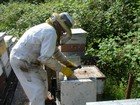
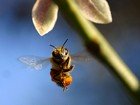

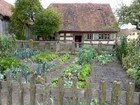
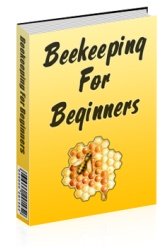
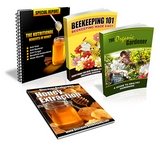
New! Comments
Do you have something of value to add? Leave me a comment in the box below.